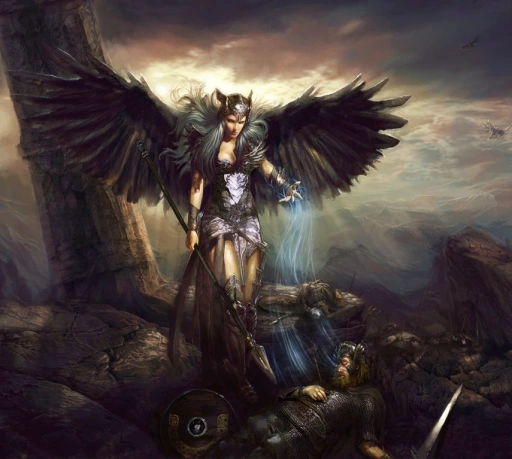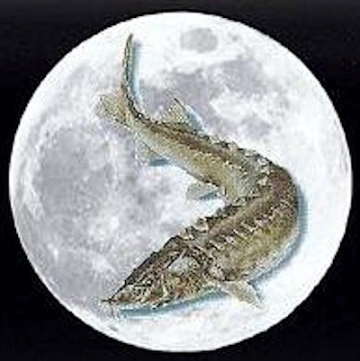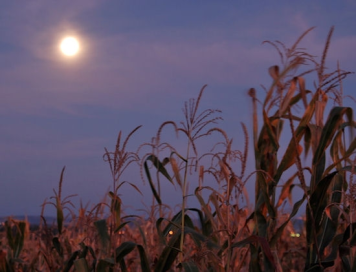
“Freyja” by Lisa Iris
“Freyja’s themes are devotion, strength, the sun, magic and passion. Her symbols are lions and strawberries. In Nordic tradition, Freyja’s name means ‘lady’. Generally speaking, it is Her domain to care for matters of the heart. In mythology, Freyja is stunningly beautiful, a mistress to the gods and She appears driving a chariot pulled by cats. When saddened, Freyja cries gold tears, and She wears a shining golden necklace (alluding to some solar associations). Many people in northern climes credit Her for teaching magic to mankind.
In astrology, people born under the sign of Leo are energetic and filled with Freyja’s solar aspect. And, like Freyja, they are ardent, dynamic lovers. If your love life needs a pick-me-up, Freyja’s your Goddess to call on. Start with a bowl if strawberries and melted chocolate that you feed to your lover. Remember to nibble passionately while noting into Freyja’s sacred food! This will digest Freyja’s energy for lovemaking. Of you’re single, eat a few berries at breakfast to internalize self-love so more loving opportunities come your way.
To improve love in other areas of your life (the love of friends, live for a job or project, etc.), wear gold-toned clothing or jewelry today to emphasize Freyja’s solar powers. This will give you more tenacity, focus and esteem for whatever you’re putting your hands and heart into.”
(Patricia Telesco, “365 Goddess: a daily guide to the magic and inspiration of the goddess”.)

“Freyja” by Kris Waldherr
In Norse mythology, Freyja is a Goddess associated with love, beauty, fertility, gold, seiðr, war, and death. Freyja is the owner of the necklace Brísingamen, rides a chariot driven by two cats, owns the boar Hildisvíni, possesses a cloak of falcon feathers, and, by Her husband Óðr, is the mother of two daughters, Hnoss and Gersemi. Along with Her brother Freyr, Her father Njörðr, and Her mother (Njörðr’s sister, unnamed in sources), She is a member of the Vanir. Stemming from Old Norse Freyja, modern forms of the name include Freya, Freja, Freyia, Frøya, and Freia.

“Norse Goddess Freja” by zoozee
Freyja rules over Her heavenly afterlife field Fólkvangr and there receives half of those that die in battle, whereas the other half go to the god Odin‘s hall, Valhalla. Within Fólkvangr is Her hall, Sessrúmnir. Freyja assists other deities by allowing them to use Her feathered cloak, is invoked in matters of fertility and love, and is frequently sought after by powerful jötnar who wish to make Her their wife. Freyja’s husband, the god Óðr, is frequently absent. She cries tears of red gold for him, and searches for him under assumed names. Freyja has numerous names, including Gefn, Hörn, Mardöll, Sýr, Valfreyja, and Vanadís.
Freyja is attested in the Poetic Edda, compiled in the 13th century from earlier traditional sources; in the Prose Edda and Heimskringla, both written by Snorri Sturluson in the 13th century; in several Sagas of Icelanders; in the short story Sörla þáttr; in the poetry of skalds; and into the modern age in Scandinavian folklore, as well as the name for Friday in many Germanic languages.

“Freyja” by Lindowyn
Scholars have theorized about whether or not Freyja and the Goddess Frigg ultimately stem from a single Goddess common among the Germanic peoples; about Her connection to the valkyries, female battlefield choosers of the slain; and Her relation to other Goddesses and figures in Germanic mythology, including the thrice-burnt and thrice-reborn Gullveig/Heiðr, the Goddesses Gefjon, Skaði, Þorgerðr Hölgabrúðr and Irpa, Menglöð, and the 1st century BCE “Isis” of the Suebi. Freyja’s name appears in numerous place names in Scandinavia, with a high concentration in southern Sweden. Various plants in Scandinavia once bore Her name, but it was replaced with the name of the Virgin Mary during the process of Christianization. Rural Scandinavians continued to acknowledge Freyja as a supernatural figure into the 19th century, and Freyja has inspired various works of art.” [1]

“Valkyrie” by TheBastardSon
Patricia Monaghan tells us that “far from the ancient Near East, home of the lustful warrior Anat, we find a Goddess who is virtually Her double: a Scandinavian mistress of all the gods who was also the ruler of death. Leader of the Valkyries, war’s corpse-maidens, this Goddess was also the one to whom love prayers were most effectively addressed.
The Goddess who gave Her name to the sixth day of our week, Freya was one form of the ‘large-wombed earth,’ another version of which Her people called Frigg the heavenly matron. Here was how Freya appeared to Her worshipers: the most beautiful of all Goddesses, She wore a feathered cloak over Her magical amber necklace as She rode through the sky in a chariot drawn by cats, or sometimes on a huge golden-bristled boar who may have been Her own brother, the fertility god Frey.

“Freyja” by mari-na
When Freya was in Asgard, the home of the deities, She lived on Folkvangr (‘people’s plain’) in a vast palace called Sessrumnir (‘rich in seats’). She needed such a huge palace to hold the spirit hordes She claimed on the battlefields, for the first choice of the dead was Hers, with leftovers falling to Odin. Like Persephone, the Greek death queen, Freya was also the spirit of the earth’s fertility; like Persephone too, Freya was absent from earth during autumn and winter, a departure that caused the leaves to fall and the earth to wear a mourning cloak of snow. And like Hecate, an alternate form of Persephone, Freya was the Goddess of magic, the one who first brought the power of sorcery to the people of the north.

“Freya” by Hrana Janto
Despite Her connection with death, Freya was never a terrifying Goddess, for the Scandinavians knew She was the essence of sexuality. Utterly promiscuous, She took all the gods as Her lovers – including the wicked Loki, who mated with Her in the form of a flea – but Her special favorite was her brother Frey, recalling Anat’s selection of Her brother Baʿal as playmate. But Freya had a husband, too, an aspect of Odin named Odr; he was the father of Her daughter Hnossa (‘jewel’). When Odr left home to wander the earth, Freya shed tears of amber. But She soon followed Odr, assuming various names as She sought him: here She was Mardol, the beauty of light on water, there Horn, the linen-woman; sometimes She was Syr, the sow, other times Gefn, the generous one. But always She was ‘mistress,’ for that is the meaning of Her own name, and a particularly appropriate double entendre it proves in Her case” (p. 127 – 128).
ASSOCIATIONS:
General: Aurora borealis (the Northern Lights), snow, spindle, spinning wheel, wheel of fortune, sword, the full moon, floral bouquets, romantic music, and the day Friday (named in Her honor).
Animals: Geese, cats, pigs, falcons, cuckoos, sparrows, and horses.
Plants: Apple, alder, birch, bramble, cypress, elder, feverfew, mint, mistletoe, mugwort, rose, tansy, thyme, vervain, yarrow, and valerian.
Perfumes/Scents: Rose, sandalwood, cypress, myrtle, vervain.
Gems and Metals: Amber, rose quartz, ruby, citrine, pink tourmaline, emerald, red jasper, jade, malachite, moonstone, silver, gold, copper.
Colors: Red, black, silver, white, and green. [2]
Sources:
Goddessgift.com, “Goddess Symbols: Freya“.
Monaghan, Patricia. The New Book of Goddesses and Heroines, “Freya”.
Wikipedia, “Freyja“.
Suggested Links:
Ashtarcommandcrew.net, “Goddess Knowledge and Wisdom – Freyja“.
Blue, Nazarri. Order of the White Moon, “Freya“.
BraveHeart Women, “Goddess Freya“.
Daily Goddess, “Freya – Sexuality“.
Goddess-Guide.com, “Freya“.
Goddessgift.com, “The Goddess Freya“.
Heathwitch. Order of the White Moon, “Freyja: Lady of Magic, Sexuality and Battle“.
Jordsvin. Jordsvin’s Norse Heathen Pages, “Some Observations on the Goddess Freya“.
Kaldera, Raven. Northernpaganism.org, “Freya’s Shrine“.
Krasskova, Galina. Exploring the Northern Tradition, “Freya (Fréo)” (p. 93 – 96).
Krasskova, Galina. Gangleri’s Grove, “Deity of the Month Guest Contribution: A Lesson from Freya“.
Krasskova, Galina. Gangleri’s Grove, “A Ritual for Freya and Frey“.
LadyRavenMoonshadow. Sacredmistsblog.com, “Goddess of the Week: Freya“.
Maris. Marispai.huginnpress.com, “M is for Mardöll“.
Revel, Anita. igoddess.com, “Freya: get back to your passion to get your passion back“.
Squidoo.com, “Freya“.
Took, Thalia. A-Muse-ing Grace Gallery, “Freyja“.
Valkyrietower.com, “Freyja – Goddess of Fertility“.
Wikipedia, “List of names of Freyja“.













































